Q-UPS+™
Universal Packet Saver implemented with VPN and Firewall
Designed to be used with any H323 compliant VoIP gateway, that is by/of itself without packetsaver feature, for routing calls, through EcoCarrier's Q-Regime-PS, to terminating VoIP gateways that are by/of themselves without the packetsaver feature.
Reduces the bandwidth required for VoIP conversation by 40 % - 48% This translates into savings of thousands of dollars every month for VoIP operation in countries where bandwidth is at exorbitant prices.
Q-UPS+ is a standalone server that is implemented with VPN and Firewall functions. It is installed between a H323 compliant VoIP gateway and the router provided by the ISP or Satellite ISP.
Q-UPS+ transparently implements packetsaving feature to the VoIP traffic that is sent by the H323 compliant VoIP gateway. The packetsaved VoIP traffic is effectively received by Q-Regime-PS, which is a softswitch that has the capability of processing the IP traffic for de-packetsaving before routing it to the terminating VoIP gateways.
Conversely, the VoIP traffic, destined for a H323 compliant VoIP gateway equipped with Q-UPS+, when routing through Q-Regime-PS, is automatically given the packetsaving treatment by Q-Regime-PS before being sent to the receiving gateway.
The packetsaving and de-packetsaving operation of Q-Regime-PS is totally transparent and seamless with respect to the two endpoint VoIP gateways involved in the VoIP call.
Other benefits offered by the Q-UPS+ Advantage
- the VPN Server of Q-UPS+ enables you to send VoIP traffic in VPN tunneling for greater security; in countries where the local ISP implements measures to block the VoIP traffic on certain ports, the VPN server offers a good way to circumvent the restriction.
- the Firewall feature of Q-UPS+ is invaluable in protecting your VoIP gateways and billing server from hackers and crackers who are bent on doing harm to your system.

Q-UPS+ and Q-Regime-PS in Operation to Save 40% - 48% on Bandwidth Requirement
VPN (Virtual Private Network) Features
VPN provides secure communications over the Internet. It establishes a virtual encrypted tunnel to safely carry data between the LAN and any point outside the network.
Site-to-Site Access
- IPSec and Triple DES (3DES)
- MD5 and SHA-1 authentication
- Unlimited licenses
Firewall
Stateful inspection technology monitors every incoming and outgoing packet, providing ultra-secure firewall security. Policies can also be set for an entire group – not required for each user – allowing both efficiency and flexibility in network security administration. Transparent Mode provides the ability to seamlessly “drop in” firewall security without disruption of existing network addresses.
- Stateful inspectionNetwork Address Translation (NAT)Network Address Port Translation (NAPT)Transparent ModeBuilt-in firewall loggingReal-time event alarmsGroup policies
- Unlimited licenses
FAQ (Frequently Asked Questions) about Q-UPS+
1. What is the price of Q-UPS+?
Q-UPS+ is priced according to its capacity for managing a certain number of concurrent VoIP call sessions as follows:
(a) Base System built in an industrial grade server running Linux Operating System in a 19” rack-mountable metal chassis with a starter capacity for managing up to 8 concurrent VoIP calls
MSRP of Base System: US$1995
(b) Software upgrade for increase in capacity for managing an increment of 8 additional concurrent VoIP calls. Upgrade can be up to a total capacity of 240 concurrent VoIP call sessions.
MSRP for increment of 10 concurrent VoIP calls is US$1000.
2. We already have a VPN Server and a Firewall, can we just purchase the Q-UPS?
Yes, you may order from us Q-UPS (without the VPN server and Firewall).
The MSRP of the Q-UPS is US$1495.
The MSRP for increment of 10 concurrent VoIP calls is US$1000.
3. Can Q-UPS+ or Q-UPS be used without using Ecocarrier's softswitching and billing service?
Yes, you can. If you intend only to send traffic between two endpoint VoIP gateways in a gateway-to-gateway mode, you may install a Q-UPS+ or Q-UPS at each end to use them to apply the packetsaving treatment to the VoIP call traffic originating from each of the endpoint gateways.
4. What does Ecocarrier charge for providing the softswitching and CDR generation service for my inbound and outbound packetsaved (by using Q-UPS+ or Q-UPS) VoIP traffic from/to any H323 compliant VoIP gateway?
Ecocarrier charges a switching fee of US$0.005/minute for routing the traffic from your originating VoIP gateways to your terminating VoIP gateways and for providing you with CDRs so that you may bill the customers yourselves. If required, Ecocarrier can also provide complete billing and invoicing for the packetsaved VoIP traffic routed through its Q-Regime softswitch. Please ask us for a separate price quote for such a service.
If your calls are terminated by Ecocarrier’s VoIP gateways instead of your VoIP gateways, there is no additional charge for the switching and de-packetsaving service.
5. What is the advantage provided by Q-UPS+ over the packetsaver that one can get as a software upgrade for Quintum's Tenor VoIP gateways?
Quintum's packetsaver feature for Tenor gateway is based on a proprietary algorithm for saving packets sent from one Tenor gateway to another Tenor gateway that is also equipped with the packetsaver feature. This packetsaver feature is useful when you want to send VoIP call traffic only between Tenor gateways that are equipped with packetsaver.
But if you have to send the VoIP call traffic from a Tenor gateway with packetsaver to another Tenor gateway that is not equipped with packetsaver or to a VoIP gateway that is not a Tenor gateway – as is often the case when you send VoIP traffic for international call termination, the packetsaver will not be used for that call.
However, Q-UPS+ working with Ecocarrier's Q-Regime-PS will not have such a problem.
6. How much bandwidth is required for a VoIP call and how does packetsaver technology work?
For answers please refer to pages II-16 to II-18 in the Quintum's Tenor Features description.